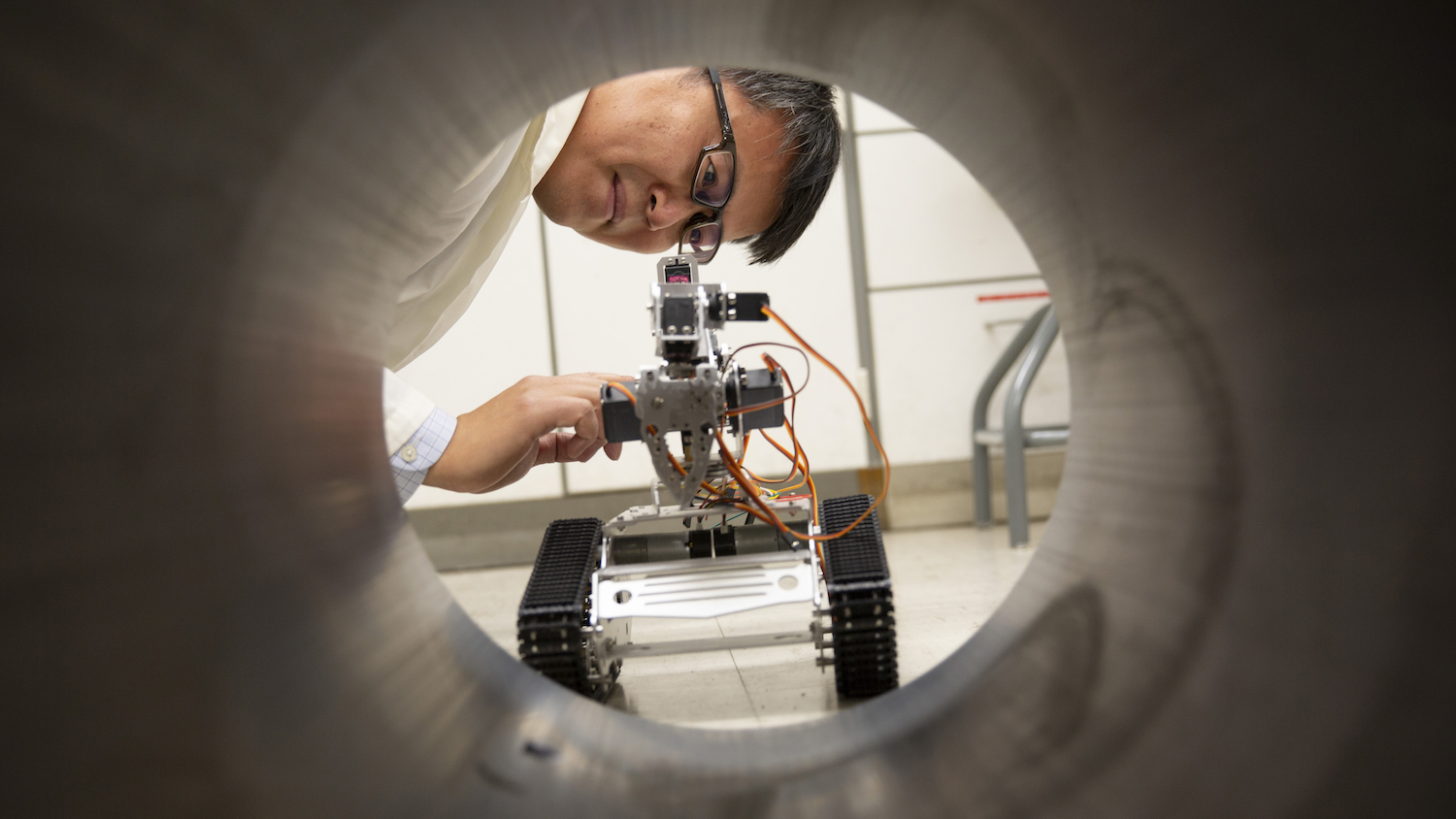
Pipe down: Preventing pipeline degradation using analytics

Above: Yongming Liu prepares to send a robot equipped with a camera and sensors to detect internal pipe damage. Liu and his team are working to develop a computer vision-based inspection tool that uses deep learning methods to provide real-time automated pipeline anomaly detection. Photographer: Erika Gronek/ASU
Natural gas pipeline infrastructure in the United States is aging, triggering deterioration rooted in multiple causes. Constructed in the 1930s and 1940s, the weakening pipelines are at risk of bursting and unleashing catastrophic consequences.
Those risks are the foremost reason why Yongming Liu, a professor of aerospace and mechanical engineering in the Ira A. Fulton Schools of Engineering at Arizona State University, is developing diagnostic and prognostic tools in efforts to improve how we maintain the structural integrity of the pipelines.
To identify the specific pipelines posing threats, Liu and postdoctoral researcher Yang Yu are leading a project supported by the U.S. Department of Transportation’s Pipeline and Hazardous Materials Safety Administration to develop a computer-vision-based inspection tool that uses deep learning methods to provide real-time automated pipeline anomaly detection.
The new tool makes possible a nonintrusive way for pipeline in-line inspection. Once the location, size and type of threats are identified, researchers can perform prognostics to predict the remaining service life of pipelines.
“This is especially critical for the decision-making on pipeline integrity management,” says Liu. “To enable more accurate predictions, we have been working on developing an information fusion framework that combines multimodal data sources in a statistically meaningful way to reduce the variance of the prediction.”
The nation’s pipeline infrastructure is vulnerable. Pipelines work in harsh environments, facing corrosion, cyclic fatigue loading, soil movement, excavating force and road traffic force. They are subject to continuous operational pressures combining the aforementioned environmental loads that contribute to complex stress conditions.
Additionally, many pipelines are made of steel and thus are prone to material deterioration such as cracking and pitting (small holes in the metal) due to aging and corrosion.
“The mechanical stresses due to operational loading and electrochemical reactions due to deterioration often interact with each other to accelerate the damage process, which is known as threat interaction,” says Liu. “We recently received funding from DOT to address the detection and characterization of interactive threats.”
Liu’s team has been awarded two grants from PHMSA’s university research program and two from the PHMSA core research program for industrial applications of state-of-art safety assurance technologies.
“All of these projects aim for the safety assessment and management from different perspectives,” says Liu. “Two of them are focusing on diagnostics using advanced data analytics and imaging techniques. The other two are focused on the hybrid physics-based statistical learning for prognostics – in other words, the remaining life prediction.”
The goal of the team’s research is to improve the safety and efficiency of pipeline infrastructure, which will not only benefit utility companies by enabling better management of pipeline operations but also benefit the general public by raising the standard of living.
The team is collaborating with Gas Technology Institute, a leading research, development and training organization for energy and environmental systems located in Chicago.
“We are not only impressed by the high-quality research by Arizona State University and Dr. Liu’s group, but also the high-quality ‘product’ of ASU — its students,” says Ernest Lever, the research and development director of energy delivery and utilization at GTI. “Several interns and full-time employees from ASU here at GTI clearly demonstrate the importance of safety-related training for next-generation engineers.”
Improving safety
Natural gas is a critical source of energy in the United States. The National Academy of Engineering identifies maintaining the natural gas infrastructure as one of its Grand Challenges.
Liu and his team are also working to address safety concerns related to the nation’s aging natural gas pipelines, especially as the demand for natural gas increases.
“Safety is always the priority for large complex engineering systems,” says Liu. “Recent progress for data science and other technology opens new doors for multidisciplinary integrated research to solve these grand challenges.”
While there has been tremendous progress in the past few decades to improve pipeline safety as new technologies, procedures and protocols have been developed to manage pipeline integrity, there are still significant challenges to pipeline safety.
“However, today, with the advances in sensing technology and the emergence of big data analytics, we now have an opportunity to fill the remaining gaps and better protect our pipeline infrastructure,” says Liu.
Beyond the pipes
Liu’s work stretches beyond pipelines. He is also the director of the newly formed Center for Complex System Safety.
Supported by Arizona Board of Regents’ Regent Innovation Fund, the new three-campus center — which includes ASU, the University of Arizona and Northern Arizona University — focuses on applying general management methodologies to many different infrastructure-related systems, like bridges, nuclear power plants and unmanned air traffic systems.
Each university will provide faculty members with multidisciplinary skills and expertise to form the center’s core researchers.
Funded through a five-year, $10 million NASA project on safety assurance and prognostics, the current work focuses on next-generation air transportation. It addresses the ongoing work of Liu’s team, as well as projects focusing on the future of Urban Air Mobility, aging infrastructure safety (including gas pipelines) and forestry safety. Expertise for the latter work is coming from NAU researchers.
Along with Liu directing the ASU research, Samy Missoum, a professor of aerospace and mechanical engineering, will lead the project’s efforts at the University of Arizona and David Auty, an assistant professor of wood science, will manage the research at NAU.
Missoum, an expert in computational design and reliability, will strengthen the center’s core objectives by developing approaches to design resilient systems and infrastructures. UA will also lead an effort in risk assessment in public health and biosystems as well as problems involving human behavior.
The work at NAU will focus on multidisciplinary approaches and strategies to predict and mitigate risks to natural ecosystems and inform better decision-making by working on projects such as wildfire hazard reduction, threats to forests and people, and forest resistance/resilience to abiotic and biotic stressors.
“We are expecting the CCSS to serve as a platform and umbrella to cultivate future collaborations among different universities in Arizona on safety-related research,” says Liu. “It is also for bridging academia, research and industrial applications. It is expected that an external advisory board will be formed in 2020 to bring together leading experts from governmental agencies and industrial partners.”
Because the center is also directly related to Liu’s current NASA project, the center will also promote the long-term development of integrating the complex data sources to support aviation safety for the air traffic system.



































